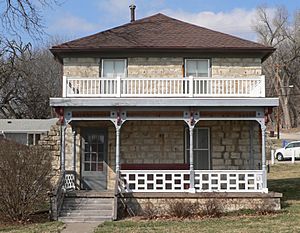Weeping Water, Nebraska facts for kids
Quick facts for kids
Weeping Water, Nebraska
|
|
|---|---|

The Heritage House Museum is part of the Weeping Water Historic District, listed in the National Register of Historic Places.
|
|

Location of Weeping Water, Nebraska
|
|
| Country | United States |
| State | Nebraska |
| County | Cass |
| Area | |
| • Total | 0.99 sq mi (2.56 km2) |
| • Land | 0.99 sq mi (2.56 km2) |
| • Water | 0.00 sq mi (0.00 km2) |
| Elevation | 1,083 ft (330 m) |
| Population
(2020)
|
|
| • Total | 1,029 |
| • Density | 1,041.50/sq mi (402.16/km2) |
| Time zone | UTC−6 (Central (CST)) |
| • Summer (DST) | UTC−5 (CDT) |
| ZIP Code |
68463
|
| Area code(s) | 402 |
| FIPS code | 31-52015 |
| GNIS feature ID | 2397243 |
Weeping Water is a small city in Cass County, Nebraska, in the United States. In 2020, about 1,029 people lived there.
Contents
The Story Behind the Name
The name Weeping Water comes from a stream that flows through the city. Native American tribes like the Oto and Omaha called this stream Nigahoe. This word meant "rustling water," describing the sound the water made over small waterfalls.
When French explorers heard the name, they misunderstood it as Nihoage, which sounded like "water weeping" to them. They wrote it down as L'Eau qui Pleure, meaning "the water that weeps." Later, this French name was translated into English as Weeping Water. Another nearby village, Nehawka, also in Cass County, is a different English version of the original Nigahoe name.
City's Beginnings
The area that became Weeping Water was first mapped out in 1867. It officially became a village in 1870 and then a city in 1888.
The Legend of Weeping Water
For a long time, people have talked about how the name "Weeping Water" came to be. Whether the story started with Native Americans or was created later to explain the mistranslation, it has become an important part of Nebraska's local stories.
One of the first times this legend was written down was in an 1871 poem called "The Weeping Water." The poem was written by Orsamus Charles Dake. He said he "developed" the story, meaning he added his own details.
The poem starts with a summary of the legend:
The Omaha and Otoe Indians, being at war, chanced to meet on their common hunting ground south of the Platte River in Nebraska. A fierce battle ensued, in which all the male warriors of both tribes being slain, the women and children came upon the battle-field and sat down and wept. From the fountain of their tears arose and ever flows the little stream known as the Ne-hawka or the Weeping Water.
Dake's poem adds more to this story. For example, it includes a tale of forbidden love between an Otoe man and the daughter of the Omaha chief. The characters in the poem speak in a grand, formal way. It is thought that Dake likely heard a version of this folktale and then expanded it into his poem.
Geography
Weeping Water covers an area of about 0.97 square miles (2.5 square kilometers). All of this area is land.
Population Over Time
| Historical population | |||
|---|---|---|---|
| Census | Pop. | %± | |
| 1880 | 317 | — | |
| 1890 | 1,350 | 325.9% | |
| 1900 | 1,156 | −14.4% | |
| 1910 | 1,067 | −7.7% | |
| 1920 | 1,084 | 1.6% | |
| 1930 | 1,029 | −5.1% | |
| 1940 | 1,139 | 10.7% | |
| 1950 | 1,070 | −6.1% | |
| 1960 | 1,048 | −2.1% | |
| 1970 | 1,143 | 9.1% | |
| 1980 | 1,109 | −3.0% | |
| 1990 | 1,008 | −9.1% | |
| 2000 | 1,003 | −0.5% | |
| 2010 | 1,050 | 4.7% | |
| 2020 | 1,029 | −2.0% | |
| U.S. Decennial Census | |||
Who Lives in Weeping Water?
According to the 2010 census, there were 1,050 people living in Weeping Water. These people made up 427 households, and 274 of those were families.
Most of the people living in the city were White (98.8%). A small number were from other racial backgrounds. About 0.7% of the population identified as Hispanic or Latino.
About 34% of households had children under 18 living with them. The average age of people in the city was 38 years old. About 26.3% of residents were under 18, and 13% were 65 or older. The population was almost evenly split between males (49%) and females (51%).
Local Culture
Weeping Water is well-known for its limestone quarry. A quarry is a place where stone is dug out of the ground. Every year, in late June, the town celebrates "Limestone Day." This special day includes a parade, fireworks, and fun games for everyone.
See also
 In Spanish: Weeping Water para niños
In Spanish: Weeping Water para niños

